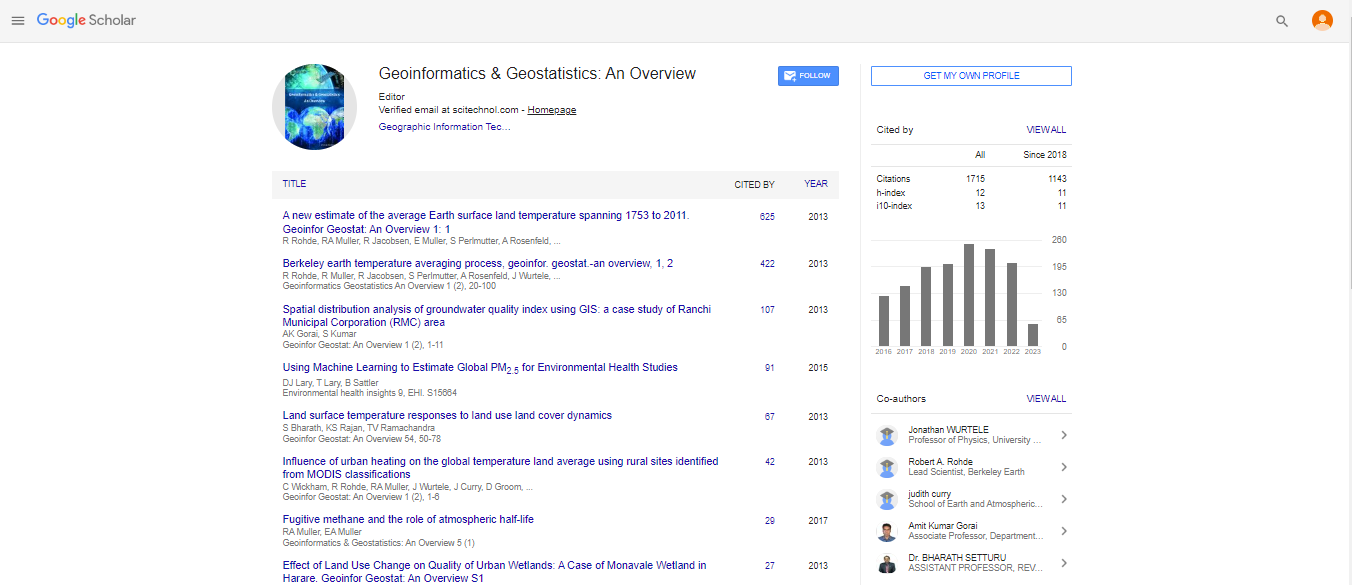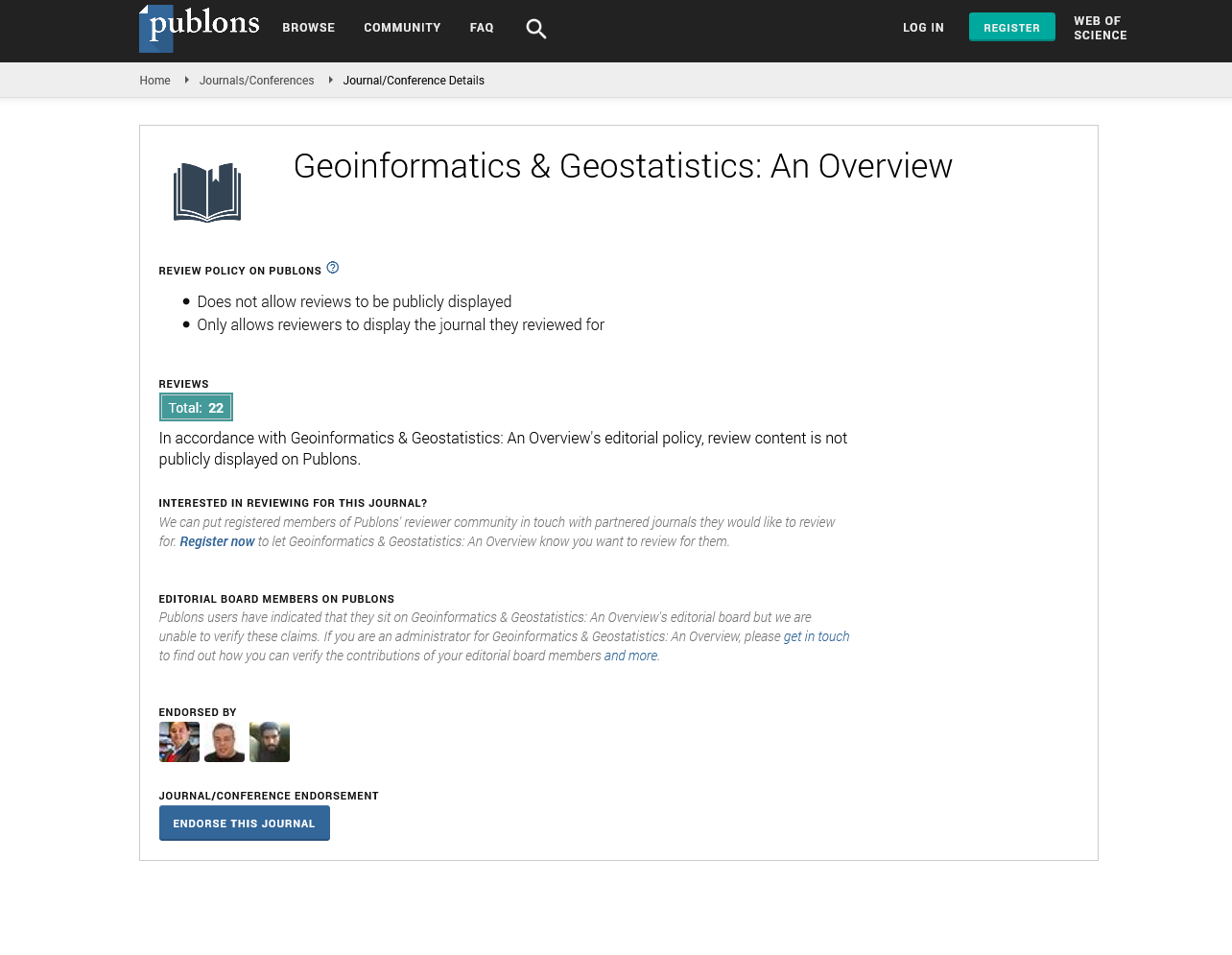Short Communication, Geoinfor Geostat An Overview Vol: 13 Issue: 3
Proximity-based monitoring of coastal river mouths
Shane Orchard1,2*, Francois Thoral1,3,4, Matt Pinkerton3, Christopher N Battershill4, Rahera Ohia4,5 and David R. Schiel1
1School of Biological Sciences, University of Canterbury, Christchurch, New Zealand
2Waterlink Ltd, Christchurch, New Zealand
3National Institute of Water and Atmospheric Research Ltd (NIWA), Wellington, New Zealand
4University of Waikato, Tauranga, New Zealand
5NgÄÂti PÅ«kenga, NgÄÂi Te Rangi, Waitaha
*Corresponding Author: Shane Orchard
School of Biological Sciences, University of Canterbury, Christchurch, New Zealand
E-mail: s.orchard@waterlink.nz
Received date: 02 May, 2025, Manuscript No. GIGS-25-165088; Editor assigned date: 06 May, 2025, PreQC No. GIGS-25-165088 (PQ); Reviewed date: 20 May, 2025, QC No. GIGS-25-165088; Revised date: 27 May, 2025, Manuscript No. GIGS-25-165088 (R); Published date: 03 June, 2025, DOI: 10.4172/2327-4581.1000435
Citation: Orchard S, Thoral F, Pinkerton M, Battershill CN, Ohia R, Schiel DR (2025) Proximity-Based Monitoring of Coastal River Mouths. Geoinfor Geostat: An Overview 13:3.
Abstract
A new study published in Remote Sensing presents a spatial framework for the routine monitoring of coastal river mouth environments using Satellite Remote Sensing (SRS) data products [1]. In article we provide a summary of this approach with a focus on the potential benefits of proximity-based sampling and its complementarity with existing approaches such as river plume tracking.
Keywords: Remote Sensing; Coastal river mouth; River radii; Islands
Introduction
Coastal river mouths are unique environments that reflect the interface between rivers and the sea. They play a major role in the health of coastal ecosystems through mediating the influence of fluvial processes on marine environments. They also provide unique habitats and essential migration corridors for many coastal species during one of more of their life stages. Monitoring these areas is important for the in situ values and as an indicator of land-water relationships that have broader consequences for marine ecosystems due to their connectivity with river catchments [2,3].
The key objectives of our study were to develop and test a spatial analysis framework that can help to monitor river mouths using freely available SRS data products that are useful indicators of environment change. To achieve this, we developed a river radii framework based on circular buffers around river end points and used these to analyse a national river network at a range of spatial and temporal scales.
River radii framework
Our initial framework was developed to assess the 226 highest-order rivers in an existing river network classification, the River Environment Classification (REC2 v2.5) [4]. These represent the largest catchments that discharge to the coast in Aotearoa New Zealand (NZ) and cover all regions on the three largest islands: Te Ika- a-MÄÂui (North Island), Te Waipounamu (South Island) and Rakiura (Stewart Island) (Figure 1). We first prepared a river end point database by completing topological checks against recent satellite imagery to establish current (2024) river mouth positions with particular attention to tidal and hÄÂpua (perched) lagoons which are characterised by shifting outlet positions. We then applied circular buffers with varying radii to the river end points in a GIS environment and clipped these to the water surface area [5]. We further divided these units according to the Coastal Marine Area which is a jurisdictional boundary used to define regional government responsibilities between land and sea and generally follows the position of the high tide line. The seaward set of these sampling units represents the coastal waters adjacent to river mouths and was the focus of our assessments.
Figure 1: Overview of the river radii framework developed for the 226 largest rivers discharging to the coast in Aotearoa New Zealand, representing stream orders 5–8 as described in the River Environment Classification (REC2) [5,6]. The base map shows spatial patterns in light attenuation (Kd) trends over the 10-year period 2023-2022 for the median Kd490 (Kd at 490nm) calculated from European Space Agency (ESA) 4km product.
In preliminary tests of the framework, we completed comparative analyses of light attenuation (Kd) data products at two different resolutions (4 km and 500 m). Estimates of light attenuation are particularly useful as an indicator of environmental health at river mouths due to their linkages with catchment-derived stressors such as suspended sediments which are a common issue for both freshwater and marine management. Our initial objectives were to investigate the radius of effects, interactions between data resolution and sampling unit size, and the effect of differing coastline geometries in the vicinity of river mouths.
The results showed strong relationships between increasing radii and decreasing (mean) Kd values consistent with an association between the intensity of light attenuation and proximity to catchmentderived influences, whilst noting that near-shore resuspension processes are also important. Comparisons of results from differing radii showed that small radii exhibited higher variance time series analyses, particularly at radii <10 km. This was associated with a greater proportion of the SRS images being discarded due to a lack of valid pixels (i.e., after validation/cloud filtering) in the sampling area. Based on these results we considered that a 10 km radii framework was likely to represent a ‘sweet spot’ that balanced the effective sample size (i.e., availability of pixels for analysis) with the specificity of the sampling unit to vicinity of individual rivers. We also found a significant influence of coastline geometry on Kd in the vicinity of river mouths across the national set of river mouths. This effect is likely to confound the interpretation of stressor levels within proximity-based sampling units and similarly could affect the delineation or observed dynamics of river plumes. Conclusions include the need to standardize or stratifying for this effect in making comparisons between rivers.
Strengths of the proximity-based approach
The consistent spatial basis of the sampling units is a key strength of the river radii framework. Unlike plume tracking studies where the study unit is derived from characteristics of the source data, the proximity-based approach offers a more generalized method for conceptualizing the coastal receiving environment at river mouths. It is applicable to a broad range of monitoring parameters and objectives and can also be readily combined with plume tracking in event scale or longer-term monitoring programmes (Figure 2).
Figure 2: Event scale monitoring example. A) River plumes visible in RGB imagery on 14 February 2023, the first clear day after Cyclone Gabrielle devastated the East Cape in Aotearoa New Zealand. B) Satellite remote sensing of the same scene using NIWA SCENZ daily data composited over 7-days post cyclone (14-20 February 2023) showing relationships between the observed plume extents and river radii sampling units centred on three river mouths (Kereu, Raukokore and WhangaparÄÂoa rivers). The radii shown cover the range 1–5 km. KdPAR is the diffuse attenuation coefficient for down welling irradiance (Kd) in the Photosynthetically Active Radiation (PAR) range (400-700 nm).
Potential applications of river radii frameworks include:
• Percentile analyses of time series data within radii provide a costeffective method for measuring the intensity of extreme events within a standardized monitoring area.
• Sensitivity analyses can be performed across a range of radii to enable the comparison of remote sensed parameters at multiple spatial scales, helping to understand how rivers impact coastal ecosystems.
Recent and upcoming advances in the availability SRS data products present many new opportunities to improve the spatial and temporal coverage of environmental monitoring programmes. The river radii framework offers a scalable and widely applicable approach that will help to harness these opportunities while remaining cost effective and complementary to plume tracking approaches.
Acknowledgement
This study contributes to a broader tau ki ÄÂkau (ridge to reef) research programme that is assessing the origins and influence of catchment-derived stressors on coastal environments in Aotearoa New Zealand (NZ). We gratefully acknowledge funding from the New Zealand Government through the Ministry for Business, Innovation and Employment (MBIE) Endeavour Fund (Grant No. UOWX2206).
References
- Orchard S, Thoral F, Pinkerton M, Battershill CN, Ohia R, et al. (2025) River Radii: A Comparative National Framework for Remote Monitoring of Environmental Change at River Mouths. Remote Sens 17(8):1369.
- Alvarez RJG, Pressey RL, Ban NC, Vance BK, Willer C, et al. (2011) Integrated land-sea conservation planning: the missing links. Annu Rev Ecol Evol Syst 42(1):381-409.
- Andersen JH, Al-Hamdani Z, Harvey ET, Kallenbach E, Murray C, et al. (2020) Relative impacts of multiple human stressors in estuaries and coastal waters in the North Sea–Baltic Sea transition zone. Sci Total Environ 704:135316.
- NIWA (2019) River Environment Classification. National Institute of Water and Atmospheric Research (NIWA) Taihoro Nukurangi.
- QGIS (2024) QGIS Geographic Information System. QGIS Association.
- Snelder TH, Biggs BJ (2002) Multiscale river environment classification for water resources management 1. JAWRA 38(5):1225-39
 Spanish
Spanish  Chinese
Chinese  Russian
Russian  German
German  French
French  Japanese
Japanese  Portuguese
Portuguese  Hindi
Hindi 


